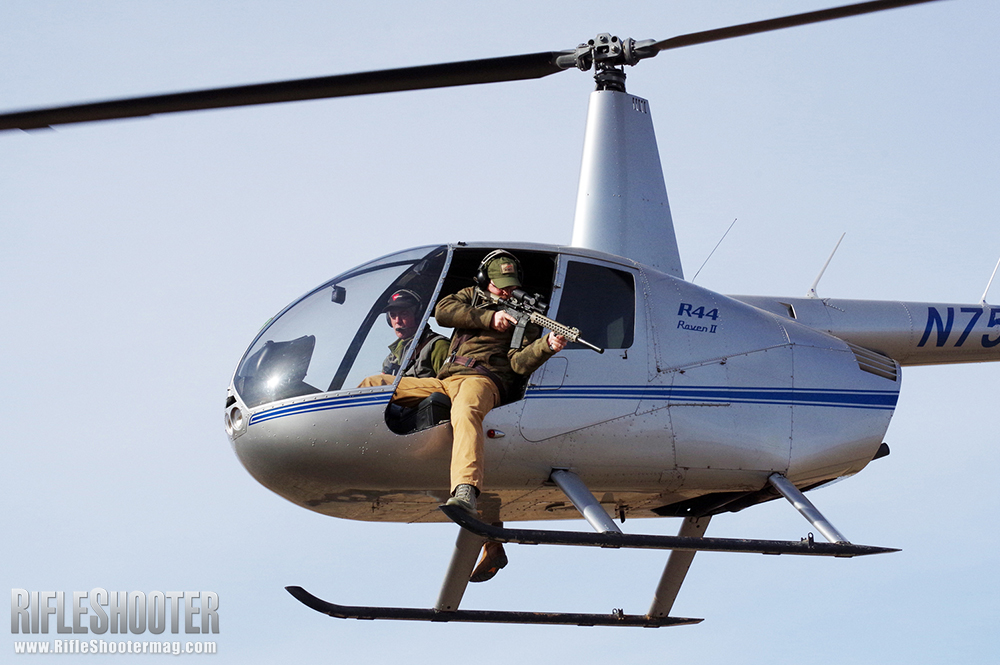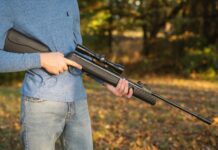
A bucket-list dream came to life when I spent two days hunting hogs with helicopter pilot Kyle Lange, and learned some intense lessons along the way. Lange estimates he fires an average of 30,000 rounds at havoc-wreaking feral hogs and coyotes annually.
As a gun guy, I’d wheeze with enthusiasm over the opportunity to shoot at simple inanimate targets out of a helicopter. Heck, the opportunity to even go up in a chopper fills me with delight. Adding a target-rich environment of invasive species just adds to the challenge and the fun.
Table of Contents
Hog Invasion
Much of Texas and the Deep South are overrun by wild hogs, and they damage millions of dollars of agricultural and native ecosystems every year. Prior to spring planting, farmers and state wildlife control make a push to reduce feral hog populations, which directly improves crop success.
Texas Parks & Wildlife estimate current feral hog populations in the Lone Star State at 1.5 million and growing exponentially every season. Young sows begin breeding around the age of six months, and their gestational period of 115 days yields up to three litters per year.
A big sounder (group of pigs) can root up acres of freshly planted crops in a single night. As a result, farmers and ranchers occasionally band together in an effort to radically reduce the population. Although it’s expensive, the most effective way – the only truly effective way – to reduce or even eliminate invasive hogs is by shooting them from a helicopter.
Hardware
Hunting feral hogs from a chopper introduces some surprising hardware considerations. For example, guns need a special shell deflector to prevent empty shell cases from flying up into the rotors and causing expensive damages – not to mention a rather abrupt landing.
Chopper rotor blades are incredibly sensitive. At one point, Lange noticed a rhythmic vibration in the chopper, which was caused by bird poop deposited on one of the blades overnight. Lange keeps specialized deflectors for AR-type rifles on hand, but sometimes shooters have to make their own – out of outlandish items such as the old motor oil bottle we fashioned onto fellow writer and Editor David Faubion’s AK.
Also, most guns will malfunction at least once during two days of hot and heavy shooting. It’s important to keep a compact cleaning kit, CLP and a small parts kit on hand.
There’s no doubt helicopter hog hunting emphasizes the value of high-capacity magazines. Lange has discovered that most AR magazines will feed up to 22 rounds or so of bulk steel-cased ammo reliably. Pack more in and you’ll have issues with some mags. He attributes it to the lesser lubricity and malleability of steel cases compared to brass.
Airborne Rifles
For decades, a good shotgun was the choice of aerial animal-control gunners. Scatterguns are still effective as ever, but they require pilots to get close – which is hard on the helicopter and tricky for the pilot. Plus, getting right down on animals with the rotor blades pounding them like a bass drum tends to scatter them in all directions, resulting in the need to climb, relocate, and pursue individual animals into thick brush. Additionally, hours of hammering heavy buckshot through a shotgun will pound even the toughest shooters into mush.
A better choice is the AR-15 rifle. Its reach allows pilots to hover a bit higher, which is easier on the machine. Animals also tend to stick together when the chopper stays higher, enabling shooters a chance to drop several hogs in quick succession. You burn through a lot of ammo – sometimes dumping a full magazine in one pass over a sounder of pigs.
The only concern I had initially was with the advisability of shooting big hogs with bulk FMJ .223 ammo. Which leads to the most surprising element of the experience: you may have to shoot a hog multiple times, but that FMJ ammo gets the job done. More often than not, hogs rolled with the first well-placed hit, and I’m pleased to say that we didn’t have a single wounded pig escape.
Ideally, heli-hog hunters should feed their rifles with something like Nosler’s 60-grain Partition or a Barnes TSX bullet – which would expand and impart much more energy – but such ammunition is far too expensive for crews shooting tens of thousands of rounds per year.
Another fantastic option would be to shoot an AR-15 chambered in .300 Blackout, which is potentially the perfect cartridge for the activity. But again, ammo cost is prohibitive. Lange did have one shooter use a .300 Blackout; he had a shell-catcher installed on his rifle and salvaged every piece of brass – often detrimental for making quick reloads.
Lange has also tried for years to make an AK-47 work. According to him, its 7.63x39mm cartridge hits pigs hard – but he hasn’t been able to get an AK to shoot with adequate precision or maintain integrity with an optic, which he considers vital for effective helicopter hog and coyote hunting.
Faubion used a Krebs Custom KV-13 on the hunt. It sported a forward optic rail, a decent trigger, and better-than-adequate accuracy. Mounted with a Trijicon RMR, it made for a fantastic close-range combat sight but was a bit coarse for use on running animals at 30 to 50 yards. Using a more precise optic like the Trijicon SRS (Sealed Reflex Sight) would have made Faubion’s setup much more helicopter-‘n-hog friendly.
Optimal Optics
A quality, non-magnified or low-magnification optic is vital to fast-paced shooting. It also needs to have very clear glass and have a fine aiming point.
Lange prefers Trijicon optics, and he’s particularly fond of the SRS. Its generous ocular lens and pinpoint red dots enables fast target acquisition and situational awareness. The SRS uses commonly available AA-batteries and is durable enough to withstand abuse and still maintain zero.
I opted to use a Trijicon VCOG in case I wanted a bit of magnification. It’s super durable, and offers true 1X (no magnification) at the low end of its 1-6x range. It worked great. After two days in the chopper, Lange was eyeing my VCOG with something I can only describe as lust.
Suppressors
Lange and other pilots prefer shooters use suppressors while shooting from the aircraft; both to minimize hearing loss and to avoid noise pollution for neighboring farmers. Even with hearing protection, the effect of hundreds of un-suppressed shots adds up quickly.
Reduced recoil is also an added benefit, making it easier to get back on target quickly. Just don’t touch that steaming hot can after a barrage of shots. Yes, I speak from experience.
Keys to Success
When shooting at wild game from a helicopter, every dimension is constantly changing. The chopper moves forward, sideways, up, down and usually a combination of directions. Animals run helter-skelter for parts unknown, and the shot distance, angle and required lead-time is always dramatically changing.
There’s simply no way to practice shooting from a moving platform, while leaning out of an aircraft and aiming at a target running in the opposite direction. You’ve got to learn on the fly (forgive the pun). Round counts tend to add up in a hurry.
Keys to success are staying loose, watching bullet impacts and adapting quickly. Be aware of the differing leads – when paralleling a running hog at roughly equal speeds, no lead is needed. If that animal is outstripping you, hold in front of it; if you’re overtaking, hold behind it. Holding behind a running animal seems counterintuitive, and it’s tough to do initially.
While not the most difficult type of shooting I’ve done – I reserve that distinction for very long shots on small targets in high wind with a precision rifle – shooting at zigzagging critters is undoubtedly the most intense shooting I’ve ever experienced.
Safety
It’s important to note that shooting from an aircraft is extremely safe. Sure, you’re hanging out of a door-less helicopter banging away at moving targets, but consider the fact that those bullets are going directly into the dirt – the potential for a ricochet is almost nonexistent. Plus, having a literal birds-eye view allows you to see any people or livestock in the area.
While most shooters don’t use a climbing-type harness, the seatbelts in choppers are secure. The craft we flew in had a five-point belt system in the front seats and a two-point system in the rear. Both were sufficient to make me feel safe while maneuvering in flight. However, if you’re skittish, bring a simple strap-type treestand harness and a carabiner for added peace of mind.
I also felt safe with Lange’s piloting experience; he’s your archetypical chopper-jockey. He often flies with his father, Aubrey, who served two tours as a medevac helicopter pilot in Vietnam. Together, they’ve net-gunned and relocated deer and exotic species for 20 years. Kyle also does aerial deer surveys and has extensive wildlife management experience. Plus, like many guys that spend their life driving a bubble in the sky through crazy maneuvers, he’s a humorist – never a dull moment.
Additional safety rules apply: While in the helicopter, “up” is no longer a safe direction for your muzzle. In fact, pilots are firm about keeping muzzles pointed down – at the ground and away from rotor blades. A negligent bullet headed through the rotor blades has drastic potential.
When flying, you’ll most likely have your gun in “hot” condition, meaning there’s a cartridge in the chamber. Attempting to remove the magazine and clear the chamber after every flurry of action is potentially more dangerous than simply putting the firearm on ‘safe’ and keeping the muzzle pointed safely out the door and down.
Doing It
Hunting from a helicopter can cost up to $800 per hour or more. If you’re like me, you don’t have that kind of unoccupied cash lying around. If you do have it, make reservations today and get up in the air. I was lucky enough to participate in my capacity as an outdoor journalist.
If you want to try something different than anything you’ve ever experienced, get up in the sky to do your part for invasive species control. It’s a trip you’ll never forget.











































